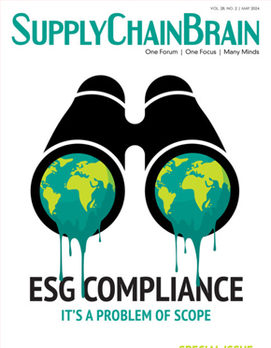
If the COVID-19 pandemic has taught us anything, it’s that we should expect the unexpected. However, that doesn’t mean we can’t be prepared for what’s next. As supply chain professionals, our job is to keep the wheels of commerce turning. But what will that job entail as the economy rebounds from the wiles of the pandemic?
There’s no doubt that the world is going to operate a little differently when life finally gets back to some sort of normal. The supply shock that began in February of last year, and the demand surge that followed it, exposed vulnerabilities in supply chains worldwide. The impact was so significant that President Biden signed an executive order calling for a broad review of American supply chains. Simultaneously, the Port of Los Angeles processed a record-breaking number of containers.
As peak season approaches, manufacturers will be under pressure to grow employment, reduce their dependence on outside resources and minimize the amount of inventory held in their supply chains. At the same time, they’re going to have to meet consumer demands for service. The challenge for many will be to make supply chains faster, more efficient and less expensive. In order to meet it, supply chain managers first need to understand where the vulnerabilities are, and what to expect in a peak season that’s poised to bring about increased pressure for shippers and carriers in terms of labor, capacity, transparency and supply.
Out of Whack
There’s a wide imbalance within the seaport shipping and receiving ecosystem. Cargo volumes are high, as imports outnumber exports. And shortages in labor and storage space at marine terminals are only making the problem worse. Because of this, serious bottlenecks are causing container dwell times to increase at the ports.
In addition, overseas manufacturing hurdles are driving last-minute changes by ocean carriers regarding where a trucker can deliver an empty container. This is forcing drivers to make extra trips, sometimes more than 40 miles from the port, costing them time and money. Typically, a driver can execute three to four container moves per day out of the port. When the distance increases, efficiency drops by nearly half, to about two container moves per driver per day.
Inefficiencies in drayage operations are adding to the complexity of the situation. When port access is restricted by available appointment slot capacity, idle times increase significantly. And that increases the risk of demurrage charges.
To combat this, a significant boost in available labor and yard space is needed. Freight carriers must be open to doing things in new ways, such as investing in systems and services that help reduce inefficiencies. At the same time, marketplaces will have to be more flexible and willing to diversify. And independent contractors will need to be prepared to fill the gaps created by these shortages.
Chassis Shortage
Inefficiencies at marine terminals are causing shortages of chassis — the trailers that transport shipping containers. Container volumes across the U.S. supply chain are stretching assets and manpower well beyond capacity. Fulfillment is currently at around 16%, as dwell times prevent chassis from coming back to the port quickly and efficiently.
As ports call on ocean carriers to share advance shipment information to help increase cargo velocity, some say the answer is to simply build more chassis. However, it takes a long time to build new equipment, and manufacturers already can’t build chassis fast enough to fill the influx of pre-peak orders. In addition, some carriers are wary of taking on too much financial liability with new equipment that could one day sit dormant. With that in mind, intermodal equipment providers (IEPs) will fill an important void.
Not only do IEPs provide flexible leasing and rental options, they also carry the load for repairing the equipment. To put the scale of current chassis maintenance requirements into perspective, there are currently 3,240 chassis in need of repair at Los Angeles and Long Beach marine terminals. Most IEPs also offer flex-leasing options, which is important because it protects carriers during down periods. However, chassis shortages are even beginning to impact IEPs. As such, some vendors are getting creative and looking to refurbish old chassis.
Sourcing old, broken-down chassis from “chassis graveyards” is proving to be a faster process than coming up with brand new ones. It’s also one of the few options available for equipment providers hoping to keep costs low. But the downside to this is that most shippers and draymen want new chassis.
Given the available options, it’s clear that there’s no perfect solution for bringing more chassis to freight carriers. However, independent marketplaces can help ease much of the strain. Driven by powerful technology, these platforms offer shippers, owner-operators and fleet managers predictive load=matching technologies that connect carriers with available loads. This helps trucking companies put more focus on moving loads and less on fleet management.
In addition to other labor shortages, the industry is facing a driver shortage. This is nothing new, as the trucking industry has struggled with a shortfall of truck drivers for nearly a decade. But the pandemic economy is making things worse. Because of this shortage, hourly rates are extremely high right now. This will intensify further during peak season.
The solution comes down to simple economics; the industry needs more drivers. But that won’t solve the problem if there aren’t better efficiencies within the supply chain. Average container and chassis dwell times have increased from three to seven days, and U.S. warehouses and shipping yards are over maximum capacity. Adding more drivers will do little good if there isn’t more capacity to move containers quickly and cost-effectively.
Price increases for fuel and other goods and services will also impact the industry during peak. Coupled with labor shortages, this means that shipping fees are going to go up — it’s unavoidable. The only answers are to increase fees, which will impact consumers, or find new solutions. Trucker-centric marketplaces that make it easy for shippers to find capacity, and for drivers to find loads, will help solve some of the problems. By better aligning chassis and drivers with loads and destinations, the industry can work against some of the obstacles it’s facing.
Digital Solutions
Over the past year, international shipping rates reached all-time highs. At the same time, U.S. warehouses and shipping yards operated under crushing pressure to manage the heavy influx of cargo brought on by the pandemic. As August approaches, shippers and carriers need to improve operational efficiencies at critical U.S. ports. Otherwise, they’ll be unable to take the added pressure of peak season.
Technology offers hope for supply chain woes, with its ability to efficiently connect all of the pieces in the ecosystem. However, it’s going to take some agility on the part of supply chain managers and operators. Change is never easy, but it will be necessary once August rolls around.
Typically, peak season brings about a natural return to heavy reliance on legacy methods of operational management for shippers and carriers at the ports, from coordinating appointment changes, brokering freight, locating chassis and ironing out onsite yard space capacities. This year, stakeholders will benefit from adopting a hybrid approach, blending reliable “back-to-basics” methods with innovations such as freight-tracking tools or digital apps that can improve supply chain transparency and facilitate better communication and problem-solving.
As unexpected changes continue to arise at the ports, compounding the effects of those the industry has already weathered this year, an increased need for transparency will mean that shippers and carriers must broaden their tool kits. By adopting new, more efficient solutions, shippers and carriers will likely see the benefit of blending all means necessary to keep the freight moving.
Richard Marks is vice president of drayage operations with Next Trucking.







